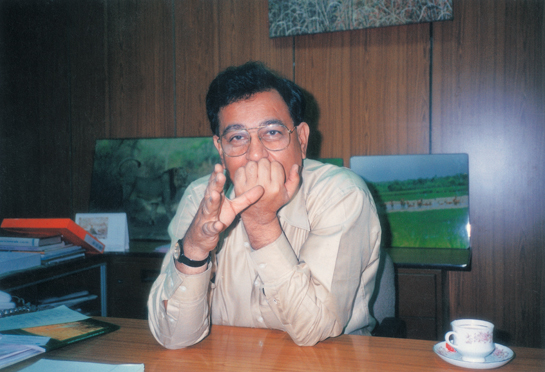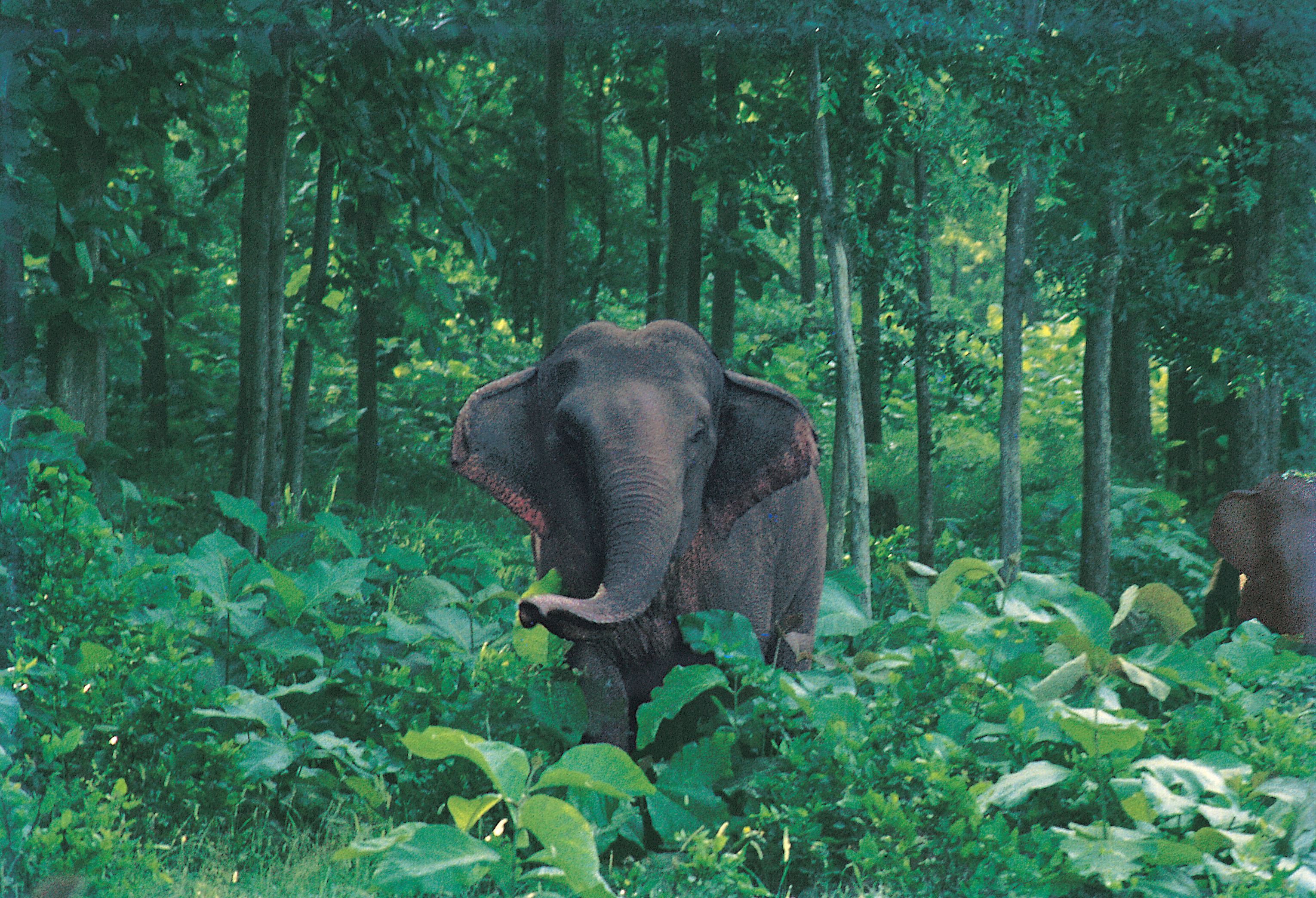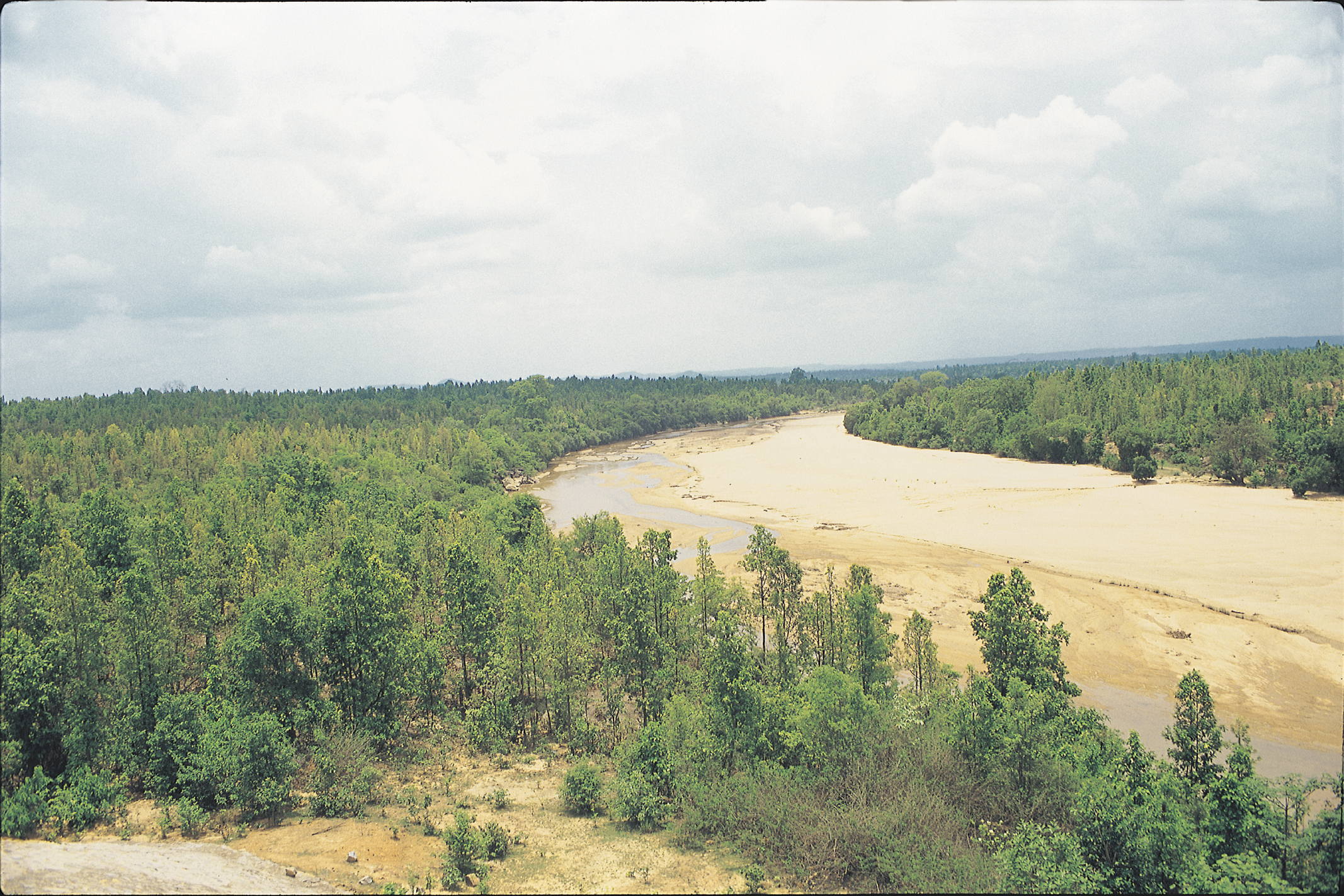Meet P.K. Sen
First published in Sanctuary Asia,
Vol. 22
No. 11,
November 2002
He speaks his mind, is not cowed down by politicians and is more comfortable with forest guards than urban sophisticates. Born in 1941 in Kolkata, he moved to Bihar in his youth. After a lifetime in the forests of Bihar, he retired as Director of Project Tiger, but not before he shook 'the establishment' by stating that the tiger was on the brink of extinction and that Project Tiger was on the rocks. As the head of WWF-India's Tiger Conservation Programme, Sen is now lending direction to a good organisation that has lost its way. Winner of the Sanctuary Lifetime Service Award 2002, P.K. Sen talks to Bittu Sahgal.
Bihar is best known for scams, corruption and inefficiency. Yet you say that Laloo Prasad Yadav can teach India how man and nature can live together.
Think about it. Who would you trust the tigers future to Chief Ministers who want to convert every square inch of their state to industry, or one who has consistently refused to let the Kotku dam drown forests and tribal lands for over a decade? People love to hate Laloo Prasad Yadav, but I have met him personally and can say with confidence that the tiger is safer with him than with those who drink wine from slender glasses and travel to world capitals.
I understand that your straight-talking caused sparks to fly with your erstwhile boss?
I presume that you are talking about Ms. Meeta Vyas, who recently resigned as the CEO of WWF-India. Sparks flew only because I believed I knew more about tigers and refused to go along with experimental ideas. In the end, she flew into a rage and accused me of everything from corruption to womanising. But I am a Bihari with staying power. I am here, she is not. But I harbour no grudges. We have a crucial task to fulfill and that is all that concerns me. WWF-India has the potential to reclaim its historic role as a defender of the tiger. I hope to help make this happen.
What seeded this passion for tigers in you?
Palamau. Having decided to join the Indian Forest Service, I spent three years in Dehradun at the Indian Forest College, then joined the Bihar Forest Department and was posted at Palamau in 1967. Anyone who has been there will understand why I fell in love with the tiger. These forests, made famous by Dunbar Brander, Sanderson and Captain Forsyth, did not merely seed my passion, they injected in me a desire to protect nature.
Was there a role model in your life?
Several! L.K. Pandey, my first Divisional Forest Officer, was the most complete forester I have ever met. I learned my field craft and my wildlife values from him. He taught me the importance of integrity, professional honesty and straight talk. Then there was S.P. Shahi, Chief Conservator of Forests, Bihar. Once a shikari, he became one of India's most passionate advocates of wildlife preservation. He taught me not to resist the build up of an emotional attachment with wildlife, something that most people of that age tended to deride. The late Saroj Raj Chowdhury's love for tigers was also infectious and he opened up a much softer world for me. And then there was the one and only M. Krishnan, storyteller, photographer and wise man who often visited Palamau while I was there.

From the late S.P. Shahi, Sen learned not to resist developing an emotional attachment to wildlife.
So wildlife conservation was a part of your life from day one?
Yes. I can't remember ever not feeling strongly about wildlife protection. In fact, even when I was in charge of administrative posts, I would pursue my passion for wildlife, for example, by introducing Wildlife Management, which I taught to frontline staff as far back as 1972.
Do you feel that state wildlife departments are adequately oriented towards protection?
No, the instinct to exploit is still deeply ingrained. Even when posted to wildlife areas, many officers keep quoting how much revenue is being lost by not working coups, forgetting the ecological services provided by forests. Such attitudes have resulted in vast areas being turned from wildlife habitats to tree farms, truncating the ecological continuity of the central Indian highlands.
Bihar itself was truncated when Jharkhand was created. How has this affected wildlife?
It will probably take years to answer that. And I doubt whether anyone is even documenting these impacts. After the division of the state, north Bihar was left with excellent linear plantations of sissoo along canal banks, railway lines and roads, but these are of no value to wildlife. A few good Protected Areas (PAs) did remain with Bihar, including Valmiki and Monger as well as some excellent wetlands, particularly along the Ganga. Twenty-five years ago, Bhimbandh was among the best PAs in India with seven large hot springs. Today, law and order problems have crippled both Bhimbandh and Valmiki. The latter still has one of the finest terai sal forests as biotic pressures are relatively low. But it hurts to see that real management inputs are missing.
What is the root of the problem?
A perennial fund shortage, which ensures that staff are not paid for months at a time and a lack of exposure among IAS officers to wildlife values are the main problems. Bihar's Kanwar Lake probably has more wintering birds than many famed wetlands, but it suffers gross mismanagement, which has caused vast portions to be silted and encroached. Fish and bird poaching is rampant. Administrative will could put a stop to this, but officers do not believe that this is a priority compared to doling out relief, building dams and excavating mines.
Can the situation be remedied?
A lot can be done. The Ganga itself is a wildlife haven and by merely ceasing to harm it, the river will return life to Gangetic dolphins, turtles, crocodiles and birds. I am working right now with forest officers in Bihar to write out a Management Plan for Valmiki, in the hope that central and state governments will implement field protection before the habitats vanish by default. Bihar has been gifted with amazing natural wealth and much of it is still intact because large-scale industrialisation as we see in Maharashtra and Gujarat is not the order of the day. But a lot of work needs to be done to improve the wildlife protection infrastructure, notwithstanding the legendary resource crunches and political self-interests that will always be stumbling blocks. With people like you and Valmik Thapar to keep prodding and poking the powers that be, perhaps the government of India may deliver more than lip service.

The jungles of Palamau (above) were where Sen was first posted. Today, this neglected park remains his first love. Photo: Kunal Verma.
If you could, over which protected areas would you wave your magic wand?
The Hazaribagh Wildlife Sanctuary, Palamau Tiger Reserve, Lawalong, Dalma, Rajgir, Topchanchi, Kabar Lake Bird Sanctuary... should I go on? Bihar is under severe threat from a series of mafias, including mining, timber and katha. We need political will and funds for protection more than magic wands.
All states seem to be facing the same deadlock.
That's true. When I was Director of Project Tiger, I travelled all over India and overseas to win support for the tiger. I noticed a sort of ˜the tiger is dying' fatalism even in the most ardent defenders of the cat. Defeatism is our greatest danger! You have often said this and that is why you launched your schools programme, Kids for Tigers.
Can kids play a role in protecting wildlife?
Of course! Children have parents, uncles and aunts who they influence right away. We do not have to wait 20 years for a child to grow up before benefiting from their support. Besides, children lend legitimacy to things. When they ask for a better, cleaner world in which tigers can survive, it is difficult for Chief Ministers or businessmen to ignore them!
You have been honoured with the Sanctuary Lifetime Service Award for 2002. You are a role model for thousands. Can you shine a beacon to guide us along the path to restoration?
I feel an overwhelming sense of humility at being bestowed this honour. I don't think I have done anything extraordinary. I just followed my heart and my instincts. As for beacons, they exist inside each of us. I cannot light one for you or anyone else. But I can promise this: when you take the first step towards any objective, the path illuminates itself. Take tigers even the diehards felt that the tiger would not survive to the 21st century. But it has. Who imagined that the Supreme Court would turn into a white knight for wildlife? Who knew that the law would actually be implemented as it was in the case of the Kudremukh judgement!
“I was posted at Palamau in 1967. Anyone who has been there will understand why I fell in love with the tiger. These forests, made famous by Dunbar Brander, Sanderson and Captain Forsyth, did not merely seed my passion, they injected in me a desire to protect nature.”
So you feel that individual inertia and apathy are key impediments?
The lack of proactive defence of our wilderness starts at the top and permeates all levels of society. I no longer take part in workshops or discussions that continue to identify the problem. We know the problem. We also know the solutions. But at a time when money is god, how do we implement solutions that involve action plans that do not line people's pockets?
Can NGOs help mitigate circumstances?
Do you think NGOs are any less corrupt than politicians? I have seen firsthand how some people who sing praises of wildlife in public profit from deals that destroy forests in private. For a list of such people, you need to merely dig up the long list of consultants to the various mega-projects who have made Paryavaran Bhavan their temple. But this should take nothing away from the fact that some of the most dedicated human beings who have spent their lives in the defence of wildlife are also in NGOs.
So what's the answer? Resources are non-existent, officers and staff unmotivated and ill-equipped and NGOs increasingly corrupt!
Having spent nearly a third of my service in and around the Palamau Tiger Reserve, I believe that the answer lies in returning to the wisdom of "ordinary" forest guards and rangers. We must listen to them. Act on their information. Respect those who patrol forests on foot. And support them against powerful people. There was a time when a superior officer would think twice before countermanding the legitimate instruction of a lowly ranger. Today, the Chief Wildlife Wardens themselves are forced to sit like lackeys outside the offices of people totally unconnected with the forest department.
Some people suggest that the way forward is to return control of forests to local communities.
Wonderful. And while you are at it, why not add a box of laddoos (sweets) for every sarpanch (village headman) as well? I am still searching for those wonderful forests that have been saved by local communities. Are there any tigers there? Elephants? Or are these sanctuaries for cows and goats? Too few people understand what it means to protect wild places. How can they understand protection, when they don't understand what the word wild means? I have seen many so-called people's initiatives. With the exception of Rajendra Singh's work in Alwar, the rest are glorified back gardens in which crops are grown, tendu collected, bamboo harvested and hundreds of people move about as though in a market place. In such a situation, will the breeding biology of wild species remain unaffected? Will natural regeneration take place?
Are you suggesting that people and wildlife must be kept at arm's length?
Not everywhere. But in some areas, there is no option but to keep parcels of land (core areas) free from human disturbance. From such areas, when biodiversity spills outwards, adivasi communities (who do far less harm to the forest than industrialists or us city dwellers) should be allowed to harvest the productivity of nature. The Sundarbans, which I recently visited, is one such classic example. But communities must not merely demand access to resources, they must also accept responsibility for protecting forests from fires, poachers, encroachers and mega-projects. Right now this is not taking place, except in tiny pockets here and there.
Can India expect any help from international sources?
We should demand, not beg for resources. Millions of dollars are being fraudulently collected in the name of the tiger and elephant from unsuspecting citizens in places as far away as the USA, UK and the European Union. Next to nothing reaches India, which has more than half of the world's wild tigers. Vast funds are consumed to feed the lavish bureaucracies of foreign NGOs. International donors are guilty of supporting "yes men" who take sustenance from their extended palms. Money meant for the tiger thus goes to experts whose expertise is largely limited to maintaining zoos, producing documents and providing fictitious reports praising donors efforts. For example, an NGO once claimed to have imparted anti-poaching training to more guards than were employed by the entire department!

Sen has spent most of his life in the forests of Bihar and it was here that he grew to love the jungle and all the life it shelters. Photo: Neeraj Vagholikar.
Let's return to Valmiki. Children in Patna are working with Tarumitra to collect signatures to save the tiger. Laloo Prasad Yadav has signed their petition. Do you think Valmiki can be saved?
Yes, provided the Ministry of Environment and Forests sheds its inexplicable apathy towards this fabulous forest. We need a special force to protect the eastern and northeastern border with Nepal. This one step will reduce over 60 per cent of timber and wildlife smuggling. It would also help to counter the growing insurrectionist and terrorist groups who depend on the wildlife trade, narcotics and prostitution for funds. You cannot blame the Field Director for not managing to do all this.
You had mentioned that it is possible to win the support of local communities. How?
Not by building highways through forests in the guise of reaching "food and assistance to villagers" as was done in Melghat! Many traditional forest-dwelling communities in areas such as Bastar want to live in peace and dignity. They should not be forced out, but equally they must not allow NGOs to use them to demand urban facilities such as tar roads and electricity. Those who live traditional lives, as dictated by their traditional cultures, are going to be key to the defence of our wildlife and forests in future and we must recognise them as allies. How simple their demands are: two square meals, drinking water, small huts and the ability to take sustenance from forests.
What about outside communities that place pressure on sanctuaries and parks?
This is a problem. Politicians and land sharks have exploited forestland in the name of tribal communities, who are actually victims themselves. Lakhs of hectares of forestland have been encroached on in the name of tribals. Thank god the Supreme Court has put a stop to this through the Central Empowered Committee. I believe that 80 per cent of rural development funds thousands of crores never reach the poor. Over 70 per cent of India's villages are deprived of basic amenities. No wonder they turn towards ever-dwindling forests and thus pose a huge threat to the tiger and other wildlife. I wish misguided human rights groups would contemplate the implications of losing even the tiny four per cent of forestland that is currently performing vital ecological functions for India.
Paint us a picture of India 50 years from now.
Only if our forest and environment laws are implemented will we even have a future! If not, the lack of water alone will turn India into a violent state with civil unrest, wars and riots everywhere. We ask very little to avoid this scenario: Keep four or five per cent of India's landmass inviolate for species protection. Allow another 15 per cent of our landmass to regenerate naturally and permit adivasi and local communities - not large corporations and politicians - the first right to resources from such lands. Together with investments to improve efficiency in our power, transport and agriculture sectors, this is the only way forward. But I will probably not be around to see whether or not such dreams will come true. Or whether the tiger lives or dies. That I leave to your Kids for Tigers.

.png)


